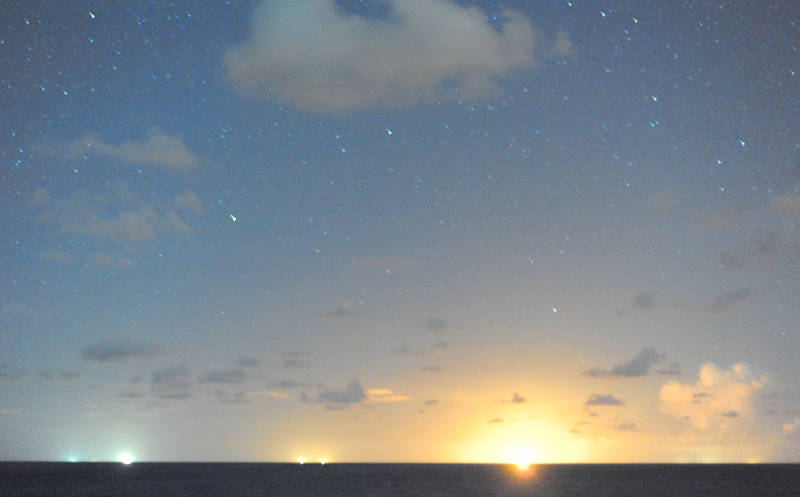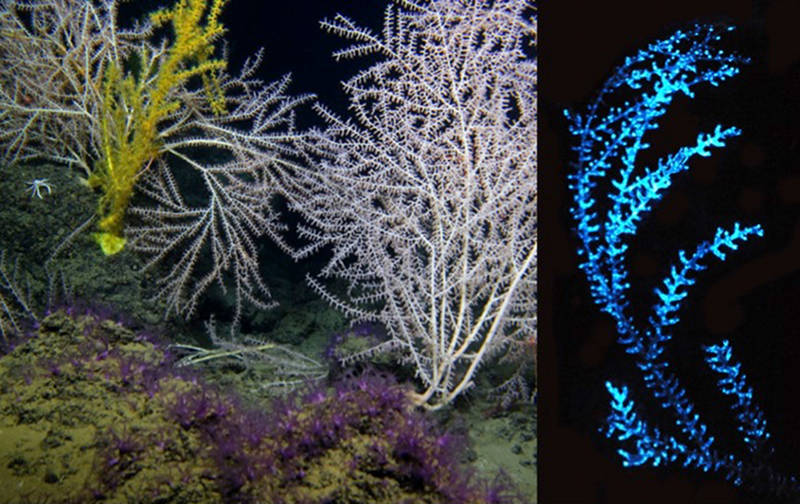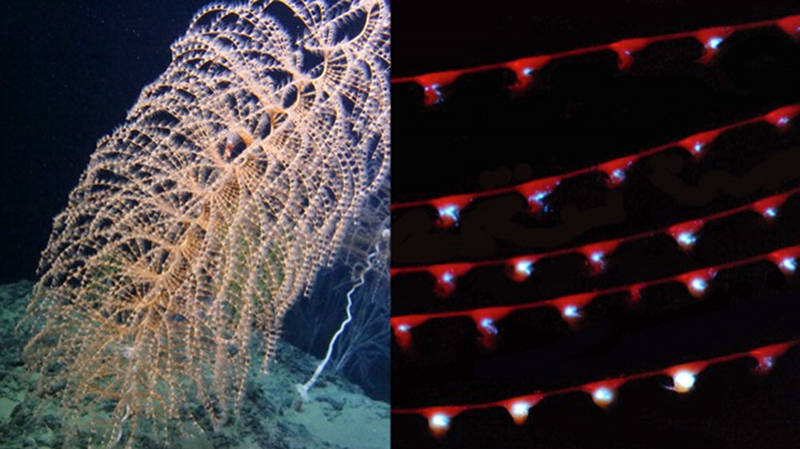
By Sönke Johnsen, Ph.D - Professor of Biology, Duke University
July 23, 2015

The deep-sea pandalid shrimp Heterocarpus ensifer and a photo of the same animal ‘vomiting’ light from glands located near its mouth. Image courtesy of Sönke Johnsen and Katie Thomas. Download larger version (jpg, 72 KB).
Some things in life are easy, like scarfing down a bag of chips. Some things start out hard and then become second nature, like driving a car. But some things are genuinely hard, all the time. Hitting a fastball, parenting a child, and – as it turns out – driving a submarine.

Figure 1: Jamie (right) and Tony (left) at the controls of the ROV Global Explorer. In Jamie’s left hand is the joystick that he uses to pilot the vehicle. The various monitors in front of them tell them what the ROV sees and where it is. Tony is monitoring the SONAR (lower middle monitor) to find a deep-sea camera system. Image courtesy of Sönke Johnsen. Download larger version (jpg, 3.2 MB).
For the past week, I’ve been watching Jamie and Tony, our two pilots, ‘fly’ their robotic deep-sea vehicle for about eight hours each day. It is not easy. First of all, they are not actually inside it. Instead, they control their ‘ROV’ (remotely operated vehicle) via a mile-long steel cable that goes from the sub itself to what looks like the back half of a U-Haul truck that is bolted to the deck of the ship. Jamie and Tony sit on two fairly comfy chairs in front of six television monitors that show different views from sub, including SONAR and navigation maps (Figure 1).

Figure 2: This is not a tropical sunset, though we have seen many beautiful ones. Note that you can see the stars, which you can’t during a real sunset. Instead, the ‘sun’ is actually a distant fire from an oil well, and the picture was taken at 11 PM under a dim crescent moon. The moonlight was just bright enough to make the sky blue, the way the sunlight makes the day sky blue. This photo was taken using a Nikon D700 from the bow of the R/V Pelican. The ship was – as always – rolling in the waves, so the exposure had to be short, which shows you just how sensitive this camera is—it can literally turn night into day and is perfect for photographing bioluminescence. Image courtesy of Sönke Johnsen. Download larger version (jpg, 2.8 MB).
Jamie has a joystick that controls the sub via two propellers, and Tony controls the robotic arm using a miniature replica of the arm that he manipulates like a sculpture. Behind them sit five eager scientists, each pushing for Jamie and Tony to turn the sub in a different direction, to take a different photograph, or to pick up a different animal. We, as scientists are naturally interested in different parts of the project and in different animals, but there’s only one ROV.
Personally, I dislike having even one person talking behind me for a minute. How Tony and Jamie manage to have five of us chattering back there for eight hours a day without completely losing it is beyond me.

Figure 3: The image on the left is an in situ photograph of a hormathiid anemone. In the image on the right is the light emitted from the same animal. The emitted light is blue and comes from a mucous secretion. The animal is not actually red, but we briefly shine a red LED on it to show where it is. Image courtesy of Sönke Johnsen and Katie Thomas. Download larger version (jpg, 99 KB).
Several things make this all even worse. First of all, the ROV is attached to the ship, which itself can be blown about by waves and wind. So it’s not uncommon for the ROV to arrive at a perfect site for photography and collections, only to be pulled backwards in a cloud of mud, like a small dog being pulled backwards on a leash.
This leads to problem two, which is the mud itself. The ocean floor is not like normal ground. It doesn’t have rivers to carry away dirt, and it doesn’t have tree roots to hold it in place. Instead, the debris from the thousands of feet of ocean above that has fallen for uncounted years simply accumulates in the deep piles of soft gray powder. Imagine not dusting your bookshelf for ten million years. So, every time the sub moves, every time it turns, and every time it stops, a cloud of this ooze is kicked up. Depending on the currents, it can take anywhere from five to 20 minutes to clear – leaving us to fill the time with discussions of critical matters like ‘why are so few state capitals the largest city in the state?’.
Finally, there is the darkness itself. The ROV is equipped with two banks of white LED lights, but even these can only show us things that are at most 40 feet away. The water swallows up light like a hole, so we wander around this enormous habitat never having any clear idea of where we are. GPS doesn’t work underwater and the SONAR analog of it can only give us a rough idea, so it’s much like hiking on a moonless night with a flashlight, except that the sun never rises and we never get to see the lay of the land. We go up and down hills, find strange little outcroppings, and see shapes in the distance, but how it all fits together is a mystery to us. It can be claustrophobic at times, and again I wonder how Jamie and Tony can do this day after day.

Figure 4: The image on the left is an in situ photograph of a hormathiid anemone. In the image on the right is the light emitted from the same animal. The emitted light is blue and comes from a mucous secretion. The animal is not actually red, but we briefly shine a red LED on it to show where it is. Image courtesy of Sönke Johnsen and Katie Thomas. Download larger version (jpg, 99 KB).
Most important to all of us is animal collection. We of course want to see and photograph the habitat itself, but to do the work of this project, we need the animals themselves. Once we spot one we want, Jamie has to park the ROV (which leads to the inevitable dust cloud that lasts long enough for a chip-and-dip run). Then Tony, with advice from the scientists, has to decide whether to slurp up the animal using a gentle suction device or to scoop it up with the arm. Even switching between these two attachments takes time and reminds me of watching the Apollo moon shots on TV, where it could take 10 minutes to open a door. Then Tony puts on his 3D goggles, which help him put the collecting device in the right place, and we all hold our breath. The shrimp and crabs are especially tricky to catch, because they can run away. They also like to swim out of the box we put them into, which means that we often lose a shrimp for every new one we collect. However, even the corals and the anemones can be difficult. These are small delicate animals and the ROV is a large steel contraption, so it’s like plucking a daisy with a steam shovel.

Figure 5: (Left) in situ photograph of a sea pen called Umbellula. (Right) Light emitted from the same animal. Note that the light comes from the base of each polyp (the flower-like structures you see in the right image). Again, a red LED was used to show the shape and position of the animal Image courtesy of NOAA Bioluminescence and Vision on the Deep Seafloor 2015. Download larger version (jpg, 87 KB).
We use the animals for various projects related to light, vision, and taxonomy, but I and my student, Katie Thomas, are primarily interested in bioluminescence. So, once the ROV is safely back on the deck, we bring the animals into a darkroom, where we have specialized equipment for measuring the color of the light emissions and for photographing the extremely dim light. We are fortunate that equipment of this sort has gotten better, cheaper, and smaller over the last 20 years.
When I started this sort of work in 1997, the device for measuring color weighed over 50 pounds and required a bulky computer and monitor and a large tank of nitrogen gas to keep the inside of the equipment dry. The whole set-up cost over $80,000. Now the device, called a spectrometer, is about the size of paperback book and can be run from a compact laptop computer. It also costs far less. The camera, which used to be a fussy specialized prototype that didn’t even work so well, is now a simple Nikon consumer model called a D700. Amazingly, it’s good enough to photograph stars while being handheld from a rolling ship (Figure 2).

Figure 6: (Left) in situ photograph of a coral called Iridogorgia. (Right) Light emitted from a few branches of the same animal. Note that it is confined to the polyps. Image courtesy of NOAA Bioluminescence and Vision on the Deep Seafloor 2015. Download larger version (jpg, 123 KB).
We turn out the lights, and Katie gently stimulates the animals (usually by touch) while I run the camera and the spectrometer. It’s tricky work because the light is often very dim and short-lasting, so things can get tense occasionally (‘I thought you said you were ready!’).
Usually, it takes about an hour to get one good spectrum and one good photo from an animal, but the results are worth it (Figures 3-6 and top photo). We don’t do much analysis at sea, since it’s hard to think clearly when you are low on sleep and half of your brain is working to keep you from falling over on a rolling ship, but later, when we get back to our various homes, we analyze the measurements and the photos to learn more about this fascinating phenomenon. It is a field with far more questions than answers, so we have a lot of work to do.